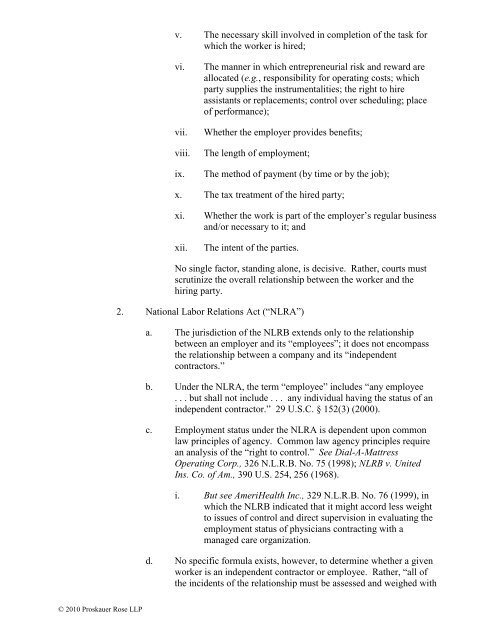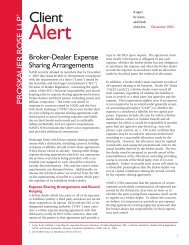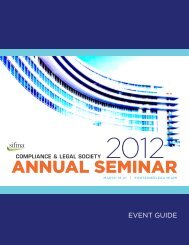Misclassification of Workers - Proskauer Rose LLP
Misclassification of Workers - Proskauer Rose LLP
Misclassification of Workers - Proskauer Rose LLP
Create successful ePaper yourself
Turn your PDF publications into a flip-book with our unique Google optimized e-Paper software.
© 2010 <strong>Proskauer</strong> <strong>Rose</strong> <strong>LLP</strong><br />
v. The necessary skill involved in completion <strong>of</strong> the task for<br />
which the worker is hired;<br />
vi. The manner in which entrepreneurial risk and reward are<br />
allocated (e.g., responsibility for operating costs; which<br />
party supplies the instrumentalities; the right to hire<br />
assistants or replacements; control over scheduling; place<br />
<strong>of</strong> performance);<br />
vii. Whether the employer provides benefits;<br />
viii. The length <strong>of</strong> employment;<br />
ix. The method <strong>of</strong> payment (by time or by the job);<br />
x. The tax treatment <strong>of</strong> the hired party;<br />
xi. Whether the work is part <strong>of</strong> the employer’s regular business<br />
and/or necessary to it; and<br />
xii. The intent <strong>of</strong> the parties.<br />
No single factor, standing alone, is decisive. Rather, courts must<br />
scrutinize the overall relationship between the worker and the<br />
hiring party.<br />
2. National Labor Relations Act (“NLRA”)<br />
a. The jurisdiction <strong>of</strong> the NLRB extends only to the relationship<br />
between an employer and its “employees”; it does not encompass<br />
the relationship between a company and its “independent<br />
contractors.”<br />
b. Under the NLRA, the term “employee” includes “any employee<br />
. . . but shall not include . . . any individual having the status <strong>of</strong> an<br />
independent contractor.” 29 U.S.C. § 152(3) (2000).<br />
c. Employment status under the NLRA is dependent upon common<br />
law principles <strong>of</strong> agency. Common law agency principles require<br />
an analysis <strong>of</strong> the “right to control.” See Dial-A-Mattress<br />
Operating Corp., 326 N.L.R.B. No. 75 (1998); NLRB v. United<br />
Ins. Co. <strong>of</strong> Am., 390 U.S. 254, 256 (1968).<br />
i. But see AmeriHealth Inc., 329 N.L.R.B. No. 76 (1999), in<br />
which the NLRB indicated that it might accord less weight<br />
to issues <strong>of</strong> control and direct supervision in evaluating the<br />
employment status <strong>of</strong> physicians contracting with a<br />
managed care organization.<br />
d. No specific formula exists, however, to determine whether a given<br />
worker is an independent contractor or employee. Rather, “all <strong>of</strong><br />
the incidents <strong>of</strong> the relationship must be assessed and weighed with




